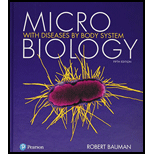
Concept explainers
Bioterrorism in the Mail?
Of course, John had had coughs before. As a 56-year-old man, he had experienced plenty of coughs, and fever, and nausea, but nothing like this. He was drenched in sweat as well as coughing nonproductively, all while being sick to his stomach. His symptoms were so bad that he had gone to the hospital. He was surprised when he was immediately admitted and shoved into isolation. All of his health care workers were garbed as if he had plague from the Middle Ages. He didn’t, but he did have a disease nearly as severe—John had inhalational anthrax. And he wasn’t the only patient: several others had been admitted with equally severe conditions. Bioterrorism had struck in the United States.
Eventually, in October 2001, the Centers for Disease Control and Prevention (CDC) recorded 10 cases of a very rare disease—inhalational anthrax. All 10 cases resulted from a bioterrorist who had mailed endospores of Bacillus anthracis in letters and packages.
Anthrax in the lungs progresses rapidly and is often fatal. Diagnosis is difficult because the disease is rare and because the initial manifestations of fever, fatigue, coughing , and nausea are common to many other diseases.
However, when laboratory scientists discovered large Gram-positive rods in samples of these patients’ sputum, they suspected anthrax. The diagnosis was confirmed by PCR specific for Bacillus anthracis and antibody detection of the capsule. Health care workers drained fluid from the lungs of the patients several times over the subsequent week and administered multiple antibacterial drugs, including ciprofloxacin and rifampin. Thanks to their rapid actions, six of the patients survived- a vast improvement over the historical mortality rate of over 90%.
Why was survival improved in 2001? Quick diagnosis and treatment with a combination of antibiotics, including the newly developed ciprofloxacin, may be reasons. Biodefense requires constant vigilance as well as innovation.
- 1. In what bioterrorism threat category does the National Institute of Allergy and Infectious Diseases (NIAID) list anthrax?
- 2. What are the other two types of anthrax?
- 3. What are advantages of multiple antibiotic therapy?
Want to see the full answer?
Check out a sample textbook solution
Chapter 26 Solutions
Microbiology with Diseases by Body System (5th Edition)
Additional Science Textbook Solutions
Organic Chemistry (8th Edition)
Anatomy & Physiology (6th Edition)
Campbell Biology (11th Edition)
Introductory Chemistry (6th Edition)
Human Biology: Concepts and Current Issues (8th Edition)
Microbiology: An Introduction
- What are Clathrin coated vesicles and what is their function?arrow_forwardHow is a protein destined for the Endoplasmic Reticulum (ER), imported into the ER? Be concise.arrow_forwardFind out about the organisations and the movements aimed at the conservation of our natural resources. Eg Chipko movement and Greenpeace. Make a project report on such an organisation.arrow_forward
- What are biofertilizers and mention the significancearrow_forwardPCBs and River Otters: Otters in Washington State’s Green-Duwamish River have high levels of polychlorinated biphenyls (PCBs) in their livers. PCBs can bind to the estrogen receptors in animals and disrupt the endocrine system of these otters. The PCBs seem to increase the estrogen to androgen ratio, skewing the ratio toward too much estrogen. How would increased estrogen affect the river otter population? Based on your reading of the materials in this unit, what factors can affect fertility in humans? Explain how each of the factors affecting human fertility that you described can disrupt the human endocrine system to affect reproduction.arrow_forwardOther than oil and alcohol, are there other liquids you could compare to water (that are liquid at room temperature)? How is water unique compared to these other liquids? What follow-up experiment would you like to do, and how would you relate it to your life?arrow_forward
- Selection of Traits What adaptations do scavengers have for locating and feeding on prey? What adaptations do predators have for capturing and consuming prey?arrow_forwardCompetition Between Species What natural processes limit populations from growing too large? What are some resources organisms can compete over in their natural habitat?arrow_forwardSpecies Interactions Explain how predators, prey and scavengers interact. Explain whether predators and scavengers are necessary or beneficial for an ecosystem.arrow_forward
- magine that you are conducting research on fruit type and seed dispersal. You submitted a paper to a peer-reviewed journal that addresses the factors that impact fruit type and seed dispersal mechanisms in plants of Central America. The editor of the journal communicates that your paper may be published if you make ‘minor revisions’ to the document. Describe two characteristics that you would expect in seeds that are dispersed by the wind. Contrast this with what you would expect for seeds that are gathered, buried or eaten by animals, and explain why they are different. (Editor’s note: Providing this information in your discussion will help readers to consider the significance of the research).arrow_forwardWhat is the difference between Uniporters, Symporters and Antiporters? Which of these are examples of active transport?arrow_forwardWhat are coupled transporters?arrow_forward
 Microbiology for Surgical Technologists (MindTap ...BiologyISBN:9781111306663Author:Margaret Rodriguez, Paul PricePublisher:Cengage LearningUnderstanding Health Insurance: A Guide to Billin...Health & NutritionISBN:9781337679480Author:GREENPublisher:Cengage
Microbiology for Surgical Technologists (MindTap ...BiologyISBN:9781111306663Author:Margaret Rodriguez, Paul PricePublisher:Cengage LearningUnderstanding Health Insurance: A Guide to Billin...Health & NutritionISBN:9781337679480Author:GREENPublisher:Cengage Medical Terminology for Health Professions, Spira...Health & NutritionISBN:9781305634350Author:Ann Ehrlich, Carol L. Schroeder, Laura Ehrlich, Katrina A. SchroederPublisher:Cengage Learning
Medical Terminology for Health Professions, Spira...Health & NutritionISBN:9781305634350Author:Ann Ehrlich, Carol L. Schroeder, Laura Ehrlich, Katrina A. SchroederPublisher:Cengage Learning Biology 2eBiologyISBN:9781947172517Author:Matthew Douglas, Jung Choi, Mary Ann ClarkPublisher:OpenStax
Biology 2eBiologyISBN:9781947172517Author:Matthew Douglas, Jung Choi, Mary Ann ClarkPublisher:OpenStax Human Heredity: Principles and Issues (MindTap Co...BiologyISBN:9781305251052Author:Michael CummingsPublisher:Cengage Learning
Human Heredity: Principles and Issues (MindTap Co...BiologyISBN:9781305251052Author:Michael CummingsPublisher:Cengage Learning





